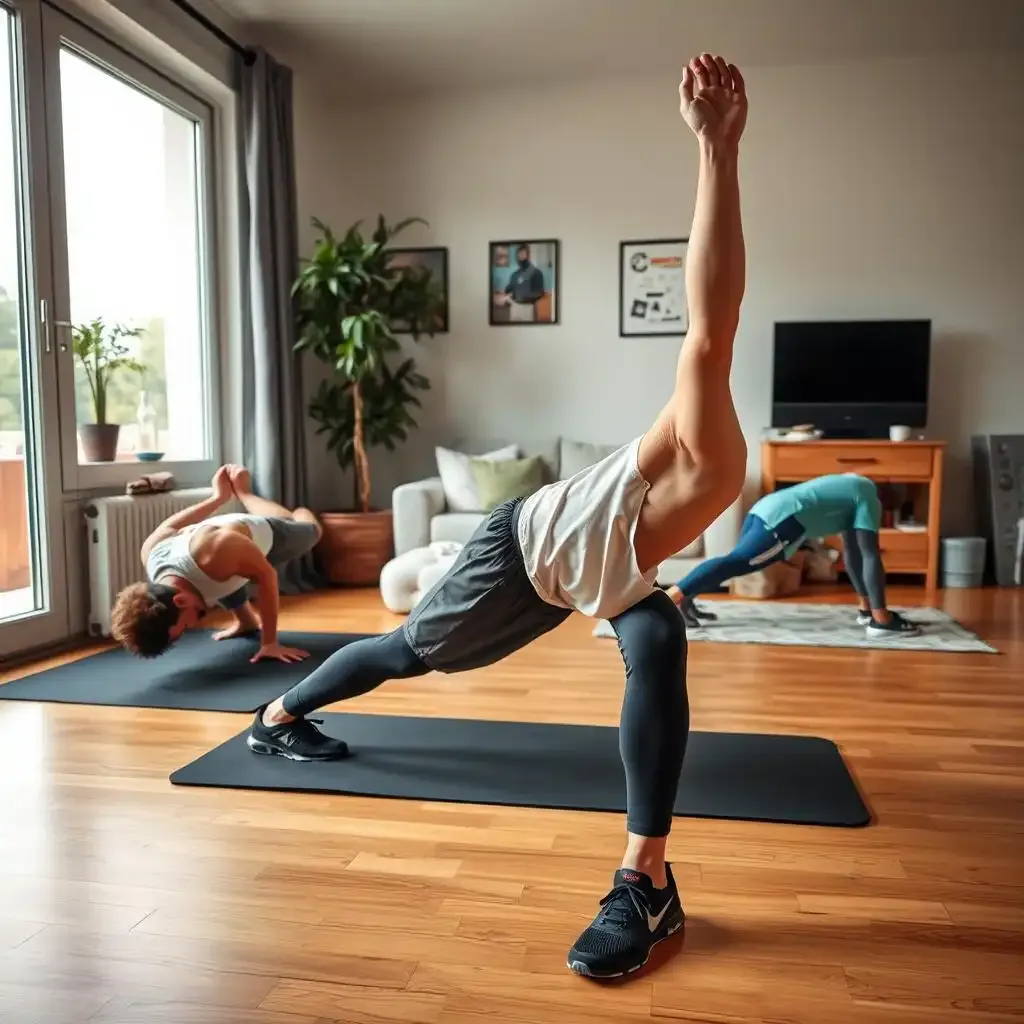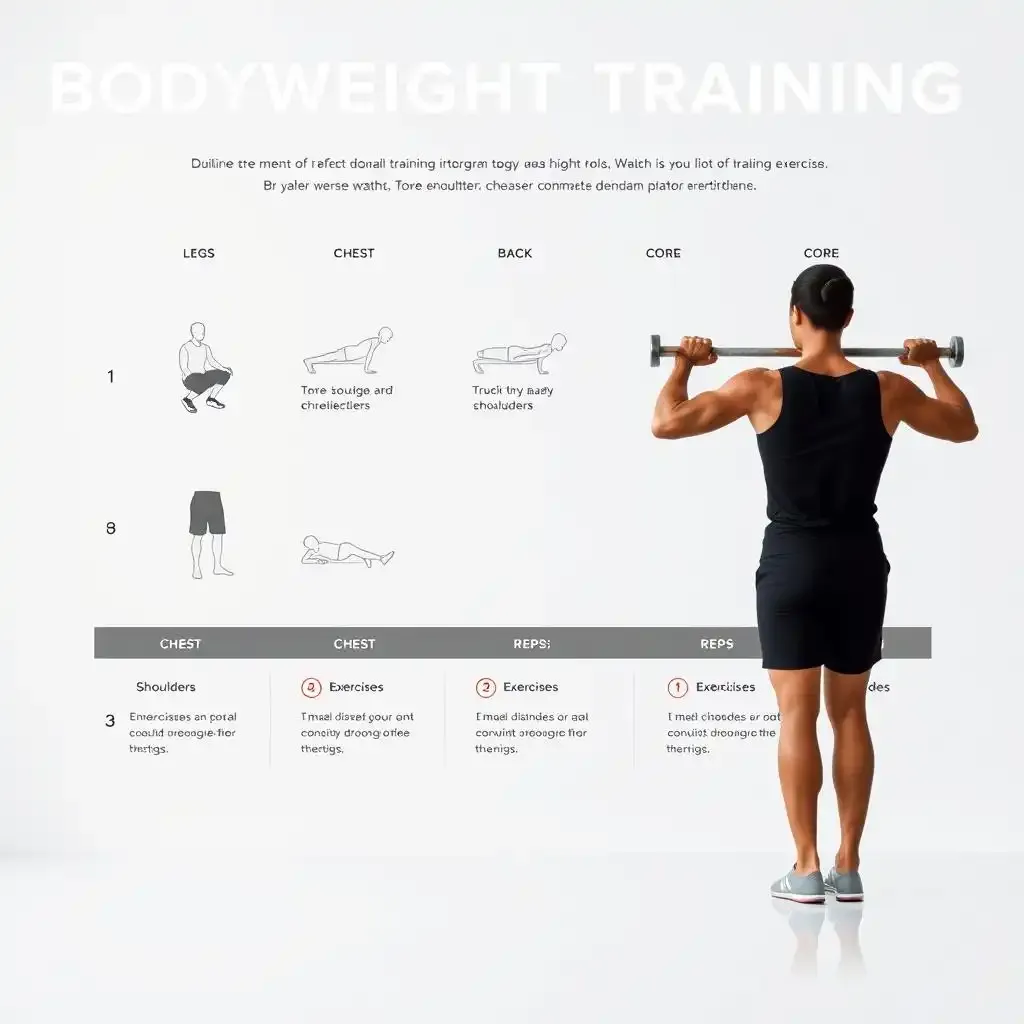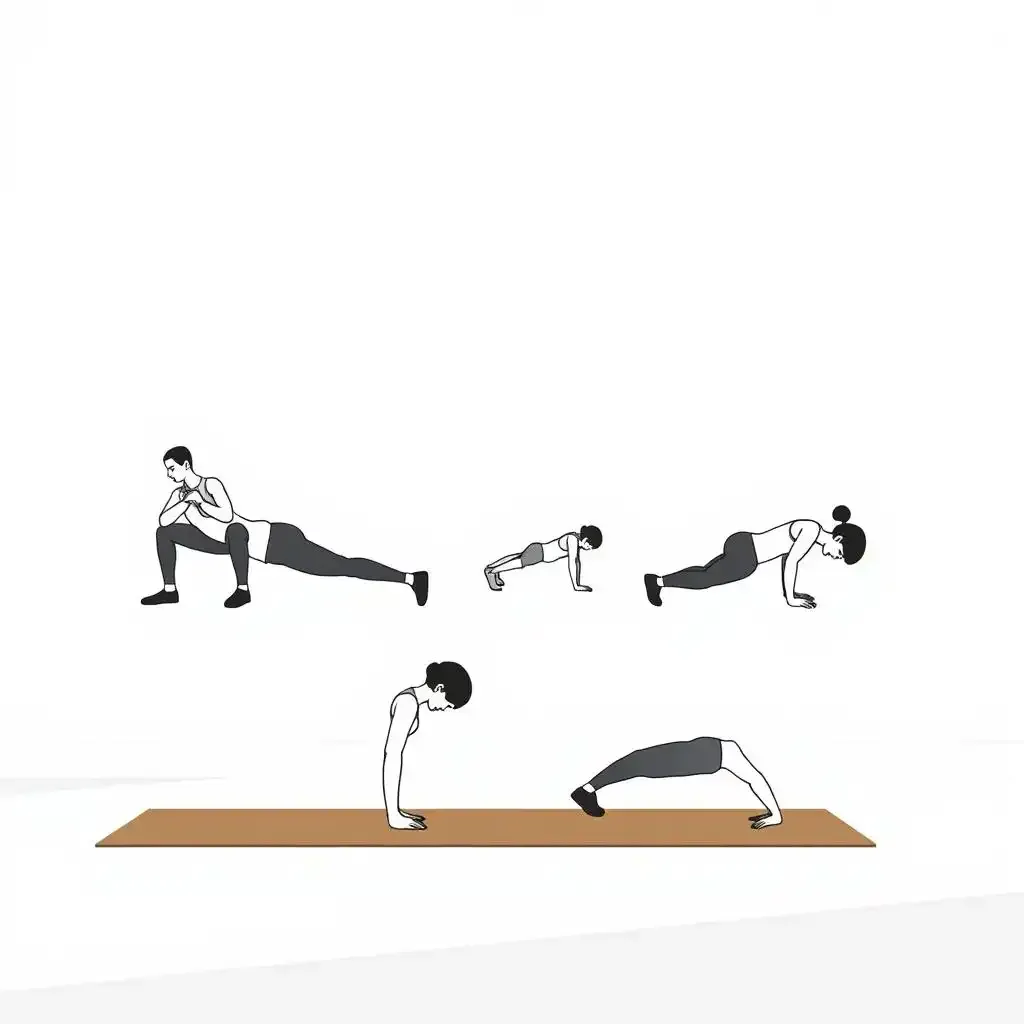Table of Contents
Hey there, fitness fanatics and couch potatoes alike! Ready to ditch the gym membership and find the incredible ability of bodyweight training? At kizworld, we believe that getting fit shouldn't require fancy equipment or a hefty price tag. Bodyweight training is a game-changer, offering a simple, effective, and incredibly versatile way to sculpt your body, boost your strength, and improve your overall health. Whether you're a seasoned athlete or just starting your fitness progression, this article will guide you through everything you need to know to begin your bodyweight training exploration. We'll cover the basics, explore some killer exercises, and help you craft a routine that fits your lifestyle. So, get ready to release your inner athlete, because with bodyweight training, the only limit is your imagination (and maybe your current level of fitness – but we'll help you build that up too!). Prepare to uncover a whole new world of fitness possibilities, right in the comfort of your own home, with kizworld.
Key Takeaway | Details |
|---|---|
What is Bodyweight Training? | Using your body weight as resistance for exercise. |
Benefits | Accessible, no equipment needed, builds muscle, burns fat, improves core strength and flexibility. |
Example Exercises | Squats, push-ups, lunges, planks, dips, burpees, mountain climbers, jumping jacks. |
Creating a Routine | Start with basic exercises, focus on proper form, gradually increase intensity and duration. |
Beginner Tips | Listen to your body, don't push yourself too hard, start slowly and build up gradually. |
Awesome Bodyweight Training: Build Strength Anywhere
Bodyweight Training: Your AtHome Fitness Revolution
Why I Fell in Love with Bodyweight Training
Hey there, fellow fitness explorers! Let me tell you, I used to think the gym was the *only* place to get serious about fitness. I mean, tons of fancy equipment, right? But then I discovered bodyweight training – and my life changed! It's like unlocking a secret superpower. Suddenly, my entire world became my gym. My living room? Squat central. My park? Pull-up paradise. No more expensive gym memberships or awkward gym selfies! Seriously, it's incredible. The best part? You can totally customize your workouts to match your fitness level. Start slow, build strength, and watch yourself transform. It’s like learning a new dance, one move at a time. And honestly, the feeling of accomplishment when you finally nail that perfect push-up? Pure gold. Think you can’t build serious strength with just your body? Check out this article on calisthenics’ effectiveness to change your mind!
Pro | Con |
|---|---|
No gym fees! | Requires discipline |
Workout anytime, anywhere | Progress can be slower than weight training |
Great for building functional strength | Needs proper form to avoid injury |
Bodyweight Training: The Ultimate Convenience
Okay, so think about this: it's a rainy Saturday. You're all cozy in your pajamas, maybe watching cartoons. Suddenly, you feel that familiar fitness pang. Before bodyweight training, I'd probably have just shrugged it off. But now? I grab my yoga mat, crank up some awesome tunes, and bam! I'm doing a killer workout in my living room. No need to battle traffic, fight for equipment, or deal with sweaty gym bros (unless you choose to workout in a public park, of course!). It's so unbelievably convenient. Plus, it’s not only about the exercises themselves. It’s about building a habit and that's something you can't build in the gym. I find it a lot easier to stick to my routine now that I can work out whenever I want, wherever I want. Want to know how often you should do calisthenics? Check out our guide on calisthenics frequency for a simple and effective plan.
- Workout whenever you want
- No travel time or gym fees
- Easy to fit into a busy schedule
- Works for all fitness levels
Mastering Bodyweight Training: Essential Exercises and Progressions
Building Your Bodyweight Arsenal
Let's talk exercises! Think of bodyweight training as a toolbox. You've got your basic tools – squats, push-ups, lunges – they're your trusty hammer and screwdriver. But as you get stronger, you'll add more advanced moves, like handstand push-ups or pistol squats. That's like getting a fancy ability drill or a super-efficient saw. It’s all about gradual progression. Don't try to build a skyscraper on a shaky foundation. Start with the basics and master them. Then, gradually add more challenging variations. It's a trip, not a race! Remember, consistency is key. Even a few minutes a day can make a huge difference. Want to learn more about specific calisthenics moves? Check out our calisthenics workout page for tons of ideas and routines!
“The body achieves what the mind believes.” – Napoleon Hill
Progressing Your Bodyweight Training
One thing I love about bodyweight training is its adaptability. You can modify exercises to make them easier or harder, depending on your fitness level. For example, if regular push-ups are too tough, try them against a wall. As you get stronger, you can progress to incline push-ups, then standard push-ups, and finally, decline push-ups. It’s like climbing a mountain, one step at a time. Each step gets harder, but the view from the top is worth the effort. And don't forget about rest! Your muscles need time to recover and rebuild. Listen to your body. If you're feeling sore, take a break. Overtraining is a real thing, and it's not fun. Want to see how calisthenics can change your body? Check out our article on calisthenics transformation for incredible before-and-after photos!
Exercise | Easy Variation | Harder Variation |
|---|---|---|
Push-ups | Wall push-ups | Decline push-ups |
Squats | Chair squats | Pistol squats |
Lunges | Stationary lunges | Walking lunges |
Crafting Your Perfect Bodyweight Training Routine: A StepbyStep Guide
Designing Your Own Bodyweight Workout
Creating your own bodyweight routine is easier than you think! First, choose a few exercises that target different muscle groups – legs, chest, back, shoulders, core. Think of it like building a balanced meal; you need different food groups to stay healthy. Next, decide how many sets and repetitions you'll do for each exercise. Start with something manageable, like 2-3 sets of 8-12 repetitions. Remember, quality over quantity! It's better to do a few exercises with perfect form than many exercises with sloppy form. And, don't forget to warm up before your workout and cool down afterward. It’s like preparing your car before a long drive. You wouldn’t just jump in and floor it, right? And finally, be consistent. Try to work out at least three times a week. Even if it's just for 20 minutes, it's better than nothing. For more tips on building strength, read our guide on strength training basics.
Sample Bodyweight Workout Routine
Here's a sample routine to get you started: Warm-up with 5 minutes of light cardio, like jumping jacks or high knees. Then, do the following exercises: Squats (3 sets of 10-12 reps), Push-ups (3 sets of as many reps as possible), Lunges (3 sets of 10-12 reps per leg), Plank (3 sets, hold for 30-60 seconds), and Crunches (3 sets of 15-20 reps). Cool down with 5 minutes of stretching. Remember, this is just a starting point. Adjust the number of sets, reps, and exercises to match your fitness level. You can easily find more advanced exercises online or in calisthenics books. If you need a structured program, check out our calisthenics classes page for details on our expertly designed programs.
Bodyweight Training for Beginners: Building a Strong Foundation
Getting Started: The Beginner's Guide
So, you're ready to give bodyweight training a try? That’s awesome! Let's start with the basics. Don't worry about looking silly or feeling awkward. Everyone starts somewhere. Begin with simple exercises that you can do with good form. Focus on mastering the fundamentals before moving on to more advanced moves. It's like learning to ride a bike; you wouldn't try to do a wheelie before you could even balance! Start slow and gradually increase the intensity and duration of your workouts. Listen to your body and don't push yourself too hard, especially at the beginning. For example, start with modified push-ups against a wall if regular push-ups are too difficult. Want to learn more about creating a simple bodyweight routine? check out our 20-minute at-home routine guide on 20-minute at-home routine.
Modifying Exercises for Beginners
One of the best things about bodyweight training is how easily you can modify exercises to suit your fitness level. Need to make a move easier? Great! Modify it! Try doing squats against a wall or chair to help maintain balance and reduce strain. Instead of regular push-ups, do them on your knees or against a wall. For planks, start by holding the position for just 10-15 seconds and gradually increase the time as you get stronger. It's all about gradual progression and finding what feels right for you. Remember, consistency and proper form are far more important than speed. Want to build strength and burn fat with bodyweight training? Read our article on bodyweight workouts for muscle and fat loss.
Bodyweight Training: Your AtHome Fitness Revolution
Mastering Bodyweight Training: Essential Exercises and Progressions
Right, so you're ready to build a body like a Greek god (or goddess!), but without all the fancy gym equipment? Awesome! Bodyweight training is like a magical toolbox. You start with simple tools – think squats, push-ups, and lunges – your basic hammer, screwdriver, and wrench. These are your foundational moves, the ones you need to master before tackling anything more advanced. Think of it like learning to ride a bike; you wouldn't try a wheelie before you can even balance, right? Master the basics, and you’ll build a solid foundation for the more challenging exercises to come. And guess what? You can do all this at home! No more excuses about not having time or money for the gym. Want some killer workout ideas? Check out our page – I promise, you’ll find something you love!
Exercise | Beginner Tip | Pro Tip |
|---|---|---|
Push-ups | Start on your knees if needed! | Try one-armed push-ups for an extra challenge! |
Squats | Hold onto a chair for balance. | Add a jump at the top of your squat for a cardio boost. |
Lunges | Hold onto a wall or chair for balance if you need it. | Try walking lunges for extra leg work. |
Now, let’s talk progression. This isn't about rushing, it's about building strength gradually. Think of it as climbing a mountain. You wouldn’t try to summit Everest on your first hike, would you? You start with smaller hills, building stamina and strength. It’s the same with bodyweight training. Once you've mastered the basic push-up, you can try incline push-ups (easier) or decline push-ups (harder). Same goes for squats – master the regular squat, then try pistol squats (one leg at a time – seriously impressive!). Want to know how to best structure your training for maximum results? Check out our guide for a detailed plan. Remember, you are building your strength, one step at a time.
- Focus on proper form above all else.
- Listen to your body, and rest when you need to.
- Don't be afraid to modify exercises to make them easier or harder.
I’ve been doing bodyweight training for years, and I’ve seen firsthand how it transforms your body and your confidence. It's not just about getting stronger; it's about building a relationship with your body and understanding its capabilities. And the best part? You don't need any special equipment! Just your own incredible self. If you're unsure where to start, our offer structured programs for all fitness levels. I promise, you’ll be amazed by what you can achieve. It’s like unlocking a secret superpower!
Crafting Your Perfect Bodyweight Training Routine: A StepbyStep Guide
Designing Your Own Bodyweight Workout: It's Easier Than You Think!
Okay, so you're ready to design your own awesome bodyweight routine? Fantastic! It's way easier than you might think. First, pick a few exercises that work different parts of your body – legs, chest, back, shoulders, and core. Think of it like making a yummy pizza; you need different toppings to make it delicious! Next, decide how many times you'll do each exercise (sets) and how many repetitions in each set (reps). Start small, maybe 2 or 3 sets of 8-12 reps for each exercise. Remember, it's all about quality, not quantity. Doing a few exercises perfectly is way better than loads of exercises done sloppily. You don't want to hurt yourself, right? And remember to warm up before you start and cool down afterward. It's like prepping your bike before a long ride; you wouldn't just jump on and go full speed, would you?
Exercise | Sets | Reps |
|---|---|---|
Squats | 3 | 10-12 |
Push-ups | 3 | As many as you can! |
Lunges | 3 | 10-12 per leg |
Sample Bodyweight Workout Routine and Next Steps
Here’s a sample routine to get you started: Warm up with 5 minutes of jumping jacks or high knees. Then, try these exercises: Squats (3 sets of 10-12 reps), Push-ups (3 sets of as many as you can), Lunges (3 sets of 10-12 reps per leg), Plank (hold for 30-60 seconds, 3 sets), and Crunches (3 sets of 15-20 reps). Cool down with 5 minutes of stretching. Easy peasy, right? This is just a starting point though. Adjust the sets, reps, and exercises to fit your fitness level. You can find tons of other exercises online or in books about calisthenics. Need a more structured plan? Check out our for expert-designed routines! Remember, consistency is key! Even if you only have 20 minutes, it's way better than nothing. Want to build serious strength? Check out our guide on .
- Find a workout buddy for motivation!
- Listen to your favorite music to keep you pumped!
- Set realistic goals and celebrate your progress!
Crafting Your Perfect Bodyweight Training Routine: A StepbyStep Guide
Bodyweight Training for Beginners: Building a Strong Foundation
Taking Your First Steps: It's Easier Than You Think!
Hey there, future fitness superstars! So, you're ready to examine into the amazing world of bodyweight training? Fantastic! Don't worry if you feel a little unsure – everyone starts somewhere. Think of it like learning to ride a bike: you don't start by attempting a wheelie, right? You begin with the basics, mastering balance and coordination before moving onto more advanced tricks. Bodyweight training is the same. We'll start with simple exercises you can easily manage, focusing on perfect form. It’s not about how many reps you do, it's about doing them correctly. We're building a strong foundation here, so patience is key. Remember that feeling of accomplishment when you finally master a new skill? That’s what bodyweight training is all about! For more inspiration, check out our page for a visual guide.
Exercise | Beginner Modification | Why it's great for beginners |
|---|---|---|
Squats | Chair squats (use a chair for support) | Builds leg strength with reduced balance challenges |
Push-ups | Wall push-ups (push against a wall) | Easier on the wrists and requires less strength |
Plank | Forearm plank (on forearms instead of hands) | Easier to maintain proper form |
Listen to Your Body (It's Smarter Than You Think):
One of the coolest things about bodyweight training is how adaptable it is. You can easily adjust exercises to match your current fitness level. Feeling a bit wobbly during squats? Lean against a wall for extra support. Push-ups too tough? Try them on your knees. It's okay to start small! The important thing is to build a solid base and avoid injuries. Remember, consistency is more important than intensity, especially when starting out. Even short, regular workouts are better than sporadic intense sessions. Think of it like watering a plant – small, regular amounts of water help it grow strong, rather than infrequent floods. Want to know how many times a week you should train? Check out our guide on .
- Start with 2-3 workouts per week.
- Focus on proper form, not the number of reps.
- Listen to your body and rest when needed.
- Don't compare yourself to others – celebrate your own progress!
Building Your Bodyweight Beast Mode:
As you get stronger, you'll naturally progress to more challenging exercises. It’s like leveling up in a video game! You start with easy challenges and gradually increase the difficulty. For example, once wall push-ups feel easy, move to knee push-ups, then regular push-ups, and eventually, even harder variations like decline push-ups. The same goes for squats and planks. You’ll find new muscles you never even knew existed! But remember, slow and steady wins the race. Don't rush into advanced moves before you're ready. Mastering the fundamentals will prevent injuries and make your overall training more effective. Want to see how calisthenics can change your body? Check out our article on for amazing results.
Bodyweight Training for Beginners: Building a Strong Foundation
Final Thought
Bodyweight training is more than just a workout; it's a lifestyle. It's about embracing the ability of your own body and using it to achieve your fitness goals. Remember, consistency is key. Start small, focus on proper form, and gradually increase the intensity and difficulty of your workouts. With dedication and a little perseverance, you'll be amazed by the strength and fitness you can achieve with bodyweight training. So, what are you waiting for? Let's get started!